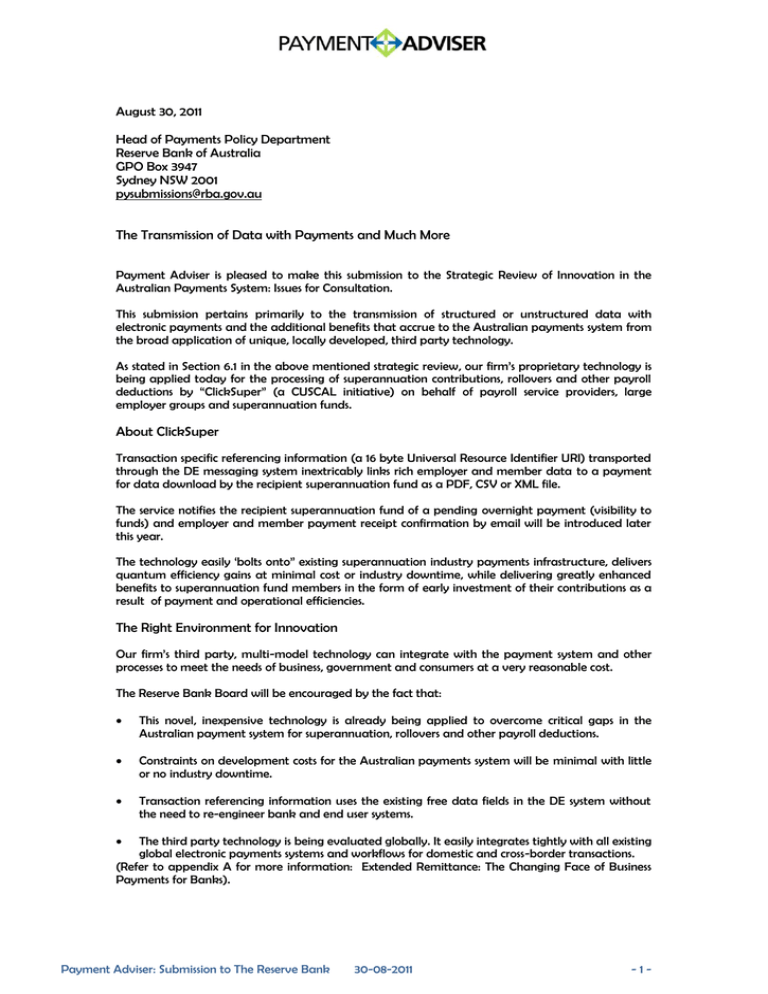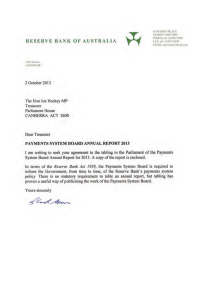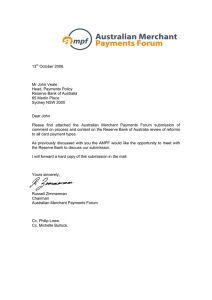Document 10842259
advertisement

August 30, 2011 Head of Payments Policy Department Reserve Bank of Australia GPO Box 3947 Sydney NSW 2001 pysubmissions@rba.gov.au The Transmission of Data with Payments and Much More Payment Adviser is pleased to make this submission to the Strategic Review of Innovation in the Australian Payments System: Issues for Consultation. This submission pertains primarily to the transmission of structured or unstructured data with electronic payments and the additional benefits that accrue to the Australian payments system from the broad application of unique, locally developed, third party technology. As stated in Section 6.1 in the above mentioned strategic review, our firm‟s proprietary technology is being applied today for the processing of superannuation contributions, rollovers and other payroll deductions by “ClickSuper” (a CUSCAL initiative) on behalf of payroll service providers, large employer groups and superannuation funds. About ClickSuper Transaction specific referencing information (a 16 byte Universal Resource Identifier URI) transported through the DE messaging system inextricably links rich employer and member data to a payment for data download by the recipient superannuation fund as a PDF, CSV or XML file. The service notifies the recipient superannuation fund of a pending overnight payment (visibility to funds) and employer and member payment receipt confirmation by email will be introduced later this year. The technology easily „bolts onto” existing superannuation industry payments infrastructure, delivers quantum efficiency gains at minimal cost or industry downtime, while delivering greatly enhanced benefits to superannuation fund members in the form of early investment of their contributions as a result of payment and operational efficiencies. The Right Environment for Innovation Our firm‟s third party, multi-model technology can integrate with the payment system and other processes to meet the needs of business, government and consumers at a very reasonable cost. The Reserve Bank Board will be encouraged by the fact that: This novel, inexpensive technology is already being applied to overcome critical gaps in the Australian payment system for superannuation, rollovers and other payroll deductions. Constraints on development costs for the Australian payments system will be minimal with little or no industry downtime. Transaction referencing information uses the existing free data fields in the DE system without the need to re-engineer bank and end user systems. The third party technology is being evaluated globally. It easily integrates tightly with all existing global electronic payments systems and workflows for domestic and cross-border transactions. (Refer to appendix A for more information: Extended Remittance: The Changing Face of Business Payments for Banks). Payment Adviser: Submission to The Reserve Bank 30-08-2011 -1- The remittance repository supports data upload in one standard or format and download in another to facilitate interoperability between trading entities. Banks adopting this technology will be able to differentiate themselves through the introduction of value add services that better meet the needs of the corporate sector. Large beneficiary banks will be able to play a major role in supply chain management and financing. Banks and other financial Institutions wishing to integrate with this technology have the option to go it alone, collaborate with each other or strategically align themselves with payment and business solution providers. We would be delighted to have the opportunity to meet with Reserve Bank staff to explain the full spectrum of benefits that Payment Adviser can deliver to enhance the Australian payment system. Yours Sincerely, Mr Brad Rosenthal Head of Marketing Payment Adviser Pty Ltd Payment Adviser: Submission to The Reserve Bank 30-08-2011 -2- Strategic Review of Innovation in the Payments System: Issues for Consultation “The Reserve Bank Board is concerned that the industry to date has not been able to provide for additional data to be carried with payments, despite a clear demand from businesses for this service. It believes that providing this capacity should be a priority.” June 2011 Payment Adviser: Submission to The Reserve Bank 30-08-2011 -3- Background Information The absence of an electronic means to carry data with payment systems is a major roadblock for business, government entities and individuals globally. Separating remittance data and payment information and having to reconcile them at a later stage using cumbersome often manual processes before receivables posting is not considered a viable option. Although financial professionals highlight a number of benefits as a result of their organisations increased use of electronic payments, trading parties around the world are having difficulty convincing suppliers to accept electronic payments because cheques (checks) still offer attributes that are not readily replicated by electronic methods. An Introduction to Payment Adviser Payment Adviser was established in 2008 to launch a proprietary technology service designed to open up new markets for electronic commerce, globally. The process of bringing the service to market began in Australia in 2004 - from concept stage, through research and development to commercial launch in 2008 and the launch of ClickSuper by CUSCAL in 2010. Late last year Payment Adviser launched an extended remittance initiative identified as “Project EverLink” at SIBOS and has been in consultation with SWIFT, Fedwire, the Clearing House, the DTCC, financial institutions and payment and business solution providers from the beginning of 2011. Project EverLink: A High Level Overview The following is provided as a high level overview of our remittance link capabilities: EverLink is third party technology developed by Payment Adviser to tightly integrate with existing global payment systems and workflows. EverLinks primary function is to deliver unlimited structured or unstructured remittance information with a payment by inextricably linking it to up to 16 characters of referencing information at payment origination. The referencing information is a Universal Resource Identifier (URI). It can be: Unique to each transaction and/or country specific based on 2-letter ISO codes. A fixed country specific reference that plays the role of any or all of the following: 1. A supplier/biller code 2. A payment originator code. 3. A secure bank account identifier that can be used in conjunction with any type of domestic or international bank or bank account identifier, Swift BIC code or equivalent. How Does EverLink Work? EverLink uses the Direct Entry (DE) Automated Clearing House (ACH) systems for payments or wire (RTGS) messaging system, or equivalents to transport the referencing information through payment systems. The reference information is then used to direct the recipient to the underlying remittance information for download and automation of cash application processing to receivables. EverLink manages the remittance data and supports remittance uploaded in one standard or format and downloaded in another to facilitate interoperability between trading entities. Payment Adviser: Submission to The Reserve Bank 30-08-2011 -4- Standard workflow notifies the recipient of a pending payment (providing early visibility to cash) by email and payment receipt notification for originators is a workflow option. EverLink streamlines all payment (AP) and payment receipt (AR) processing workflows. All parties to a payment (e.g. the recipient‟s bank, intermediary institutions etc) can view or access the payment and underlying information and referencing information can be applied to access remittance information at a later date for audit and other purposes. Who Benefits? Corporates will benefit through direct connectivity to banks for straight through processing of domestic and cross–border payments, eliminating manual intervention in the payment process. Businesses and government entities irrespective of their scale will be able to: Streamline existing AR & AP workflows. Reduced costs. Improved visibility into their cash positions. Banks now have the means to differentiate themselves from non-bank institutions through the introduction of value add services that better meet the needs of the corporate sector. Banks will be able to maintain critical banking services that; Support and follow industry standards. Ensure data integrity and completeness. Process their payments efficiently and accurately. Play an extended role in supply chain management and financing. ClickSuper an Australian Application A live application for Australian pension (superannuation), rollovers and other payroll deductions has been in operation for more than twelve months with CUSCAL a leading business-to-business provider of wholesale banking services (refer www.clicksuper.com.au ) Regular monthly payments are processed to superannuation funds, insurers and government agencies on behalf of payroll service providers and larger corporate in Australia. ClickSuper accepts XML and Excel remittance information, aggregates data and makes payments on behalf of payroll service providers and large corporations. Workflow notifies the receiving institution that a payment will be received within 24-48 hours, controls access to data via referencing information and authentication and delivers it as an XML or CSV file for straight-through-processing or as a PDF for manual processing. Later this year a workflow upgrade will notify superannuation fund members and their employers when contributions have been received by their fund ready for account allocation and investment. Payment Adviser: Submission to The Reserve Bank 30-08-2011 -5- Appendix A Extended Remittance: The Changing Face of Business Payments for Banks Update August 2011 The following notes are regularly updated to provided background information for discussions with SWIFT, Fedwire, The Clearing House, DTCC, the banking industry and payment and business process providers globally: Cheques (Checks) Payments are undergoing an unprecedented period of change in all markets. The use of paper and cheques (checks) for business-to-business payments has declined steadily over the past decade primarily in favour of electronic and wire payments. In the US, the check itself is evolving: paper checks are being “electronified,” either through check imaging or conversion to electronic debits (ACH debits). Many financial institutions believe that cheques will be phased our for business payments by the end of this decade. Electronic Payments Although financial professionals mention a number of benefits as a result of their organisations increased use of electronic payments, domestic trading parties around the world are having difficulty convincing suppliers to accept electronic payments because cheques (checks) still offer attributes that are not readily replicated by electronic methods. The absence of an electronic means to carry data with payments remains a major roadblock for all business and government entities. Separating remittance data and payment information and having to reconcile them at a later stage using cumbersome often manual processes before receivables posting is not considered a viable option. Apart from extending direct entry systems to provide more information for reconciliation purposes in the UK and Europe, the US is the only country that has introduced the means to carry data with payments. The ACH payment system delivers standards-based, structured data. Payment originators can deliver up to 9,000 bytes of structured payment remittance information (invoice number, invoice data, purchase order numbers, invoice gross amount, amount paid, discounts taken adjustments and adjustment codes) for up to 30 invoices with a payment. The US is ERP-centric and the innovators of this initiative TCH are working with finance industry leaders, accounting software vendors and businesses to remove all barriers to adoption. High value wire systems Fedwire and CHIPS (RTGS) will start to deploy a similar 9,000 byte, expanded remittance solution ERI on November 21, 2011. The goal of ERI is to enable large beneficiary companies to automate cash application posting to receivables and remove the need to match payment details manually. Payment Adviser: Submission to The Reserve Bank 30-08-2011 -6- US banks can use one of three formats to transmit the ERI over CHIPS and Fedwire in order provide a business-to business capability that large corporations have been seeking for domestic wire transfer payments for many years. Swift MT 103 Remit and CHIPS will carry the 9,000 characters of ERI for delivery to beneficiaries outside the US. Banks outside the Swift closed user group will be required to join the group to facilitate cross-border payments with ERI until Swift develops a more comprehensive global strategy to both transport and deliver this information. N.B. EverLink can facilitate cross-border payments with ERI beyond the Swift user group. We are in discussion with SWIFT about establishing a proof of concept (POC). Secure Bank Account or Other Identifiers Secure account identifiers have been adopted in the US and Canada to mask bank account details to protect against fraud. Secure bank account identifiers enable suppliers (billers) to publish electronic payment instructions on invoices, websites and in the public domain. Any entity can register a validated bank account held in their name via a participating bank or financial institution. N.B. EverLink referencing informationt can be used in conjunction with any type of domestic or international bank or bank account identifier, Swift BIC code or equivalent. Future Initiatives Secure Bank Account or Other Identifiers Many professionals expect that other countries will adopt similar initiatives in the near future. EverLink supports this innovation and any entity or individual can register a validated bank account held in their name via an EverLink participating bank or financial institution. Legal Entity Identifiers In July 2011 a global coalition of financial services firms and trade associations published recommendations that ISO, Swift and the DTCC were best placed to operate a global LEI system. All organisations are aware of our technology and its potential to be used in conjunction with LEI‟s. Summary Everlink has been developed for the banking industry to meet the changing face of payments. Although many believe core revenue streams for banks will not include payments by the end of this decade, project Everlink‟s multi-model, innovative technology has the potential to turn these predictions upside down as it provide banks with the means to differentiate themselves and provide value add services to meet the needs of corporate sector. For more information contact Brad Rosenthal: Email: brad@paymentadviser.com Payment Adviser: Submission to The Reserve Bank 30-08-2011 -7-




